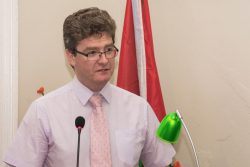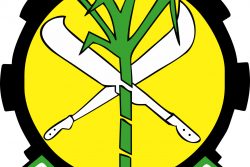The US Center for Strategic and International Studies on Tuesday issued its latest analysis of Venezuela’s strategy in relation to Guyana following its inaugural report which was published on February 7 this year. On that occasion it described the military build-up in the Cuyuni, particularly on Ankoko, as well as on the Caribbean coast. The current review indicates that the construction and expansion of the military base on Ankoko is continuing, with progress being made in the building of a bridge across the Cuyuni to the island and new pathways connecting the island to the ferry landing. Satellite images too show a railroad under construction linking the ferry crossing to the airfield that was not there in February.
Then there are the 75 field tents near the airfield which CSIS says is enough for a battalion-sized unit of several hundred personnel. It goes on to say that the aircraft and the base had been used to train paratroopers and special operations personnel, as well as to simulate land and maritime operations. On the Atlantic coast too at Guiria the report estimated that there were now five to six missile boats out of an estimated total of seven in the Venezuelan navy. Social media accounts also showed Su-30 fighter jets.
Whatever the exact number of missile boats, the CSIS wrote that they pointed “to a significant concentration of firepower for a comparatively minor coast guard installation” which was sited far from the military’s main facilities. The think tank went on to say that as of May 8, at least two of the missile boats together with one Págalo patrol vessel, appear to have arrived at Point Barima, which is a secondary coast guard station. It had been reported in February that it was undergoing an upgrade, and this new development was concerning, said the report, because Venezuelan missiles and naval forces were now “within arm’s reach” of Essequibo.
With regard to this continuing build-up of forces in the Cuyuni and on the coast, CSIS perceptively remarks that “[O]ne of the most concerning possibilities is that Maduro will fall victim to his own rhetoric. He has whipped up nationalist passions without providing an escape valve.” It may not be in his interest to have a full-scale conflict with Guyana, but his rhetoric shackles his “political reputation” to a preparedness to back his words with force, especially where the armed forces are concerned.
Independently of that it should be said that the armed forces have always been very hard-line on the matter of Essequibo, and even at the time when the Teknik Perdana was seized by the Venezuelans in 2013, there was never absolute clarity about whether this had emanated from the politicians in Caracas, or whether it was the navy which was behind it. Be that as it may, to maintain himself in office by illegal means Mr Maduro needs the military, so if he builds them up for an invasion over an extended time-frame, he may find at some point he cannot suddenly tell them to stand down. In the end, they may tell him what has to happen. Whatever the case, as CSIS describes it, the Maduro regime “has likely unleashed a genie that will be difficult to put back in the bottle.”
The report also argued that President Maduro was copying his “idol”, Vladimir Putin. “Scholars writing on Russia’s war in Ukraine,” it said, “noted Putin’s domestic transition to a war footing well before the full-scale invasion.” It is not just CSIS which sees a parallel with Ukraine. It seems the Venezuelan government from an entirely different angle is taking Ukraine as an example. “Just as they [the US et al] prepared Ukraine against Russia, they have prepared Guyana for that, underestimating us, they do not know what we are capable of doing in the face of threats and anything that arises,” Defence Minister General Vladimir Padrino López was quoted by the state news channel as saying.
The think-tank analysis went on to describe how any move on the part of Guyana to reinforce its defences is interpreted as “an offensive preparation for war, mostly impelled and directed by the United States and its corporations.” This is not something which the authorities in this country should be unaware of, given that Minister Padrino was still telling the Venezuelan public only recently that “Guyana has been turned precisely into the epicentre of the greatest threat to peace in South America and to Venezuela … there are 12 CIA bases and 14 secret bases of the Southern Command already at this moment on the ground in Guyana; in due course the evidence will be shown.” That he can’t show evidence which doesn’t exist is no impediment as far as he is concerned to making these kinds of outrageous claims.
As in the period prior to the holding of the referendum on Essequibo, Venezuelan commentators once again are saying that Mr Maduro’s military manoeuvres are connected to the postponement of the July 28 election, if not its cancellation. Sadio Garavini, a political scientist and one-time Venezuelan ambassador to Guyana, reportedly told Voice of America that the government’s current steps in relation to Essequibo were “based on internal politics” and that there was a real possibility of an incident with Guyana or an international ally which could impact the election, postponing it.
Félix Gerardo Arellano, another political scientist described the issue of Guyana as being more of a domestic policy issue than a “complex foreign policy issue,” while academic Ryan Berg, in the same field, described the cancellation of the election as being a “real consideration” for Maduro. Tal Cual reported him as suggesting three possible arguments which could be put forward to justify such a cancellation: the alleged installation of military bases in Guyana and the subsequent threat of “invasion”; “terrorism” or sabotage directed at the electoral authority; or an alleged coup d’êtat promoted by the opposition.
That said, CSIS has a note of caution: “While the period between now and July 28 is a risky time for Maduro,” it writes, “there is also a risk he may seek to manufacture a crisis after the election, too.” In fact, he “may be tempted to ramp up both rhetoric and action related to the Essequibo in a true gambit to manufacture a regional crisis in the aftermath of a stolen election.”
While one presumes that the Government of Guyana is aware of the continued militarisation of Ankoko and associated areas of the Cuyuni, not to mention the naval build-up in Guiria and Point Barima, it has had nothing to say about it in recent times. Even more perplexing is the fact that it has not yet commented on this latest CSIS report, not even providing a summary in the state newspaper or a statement for the Department of Public Infor-mation. That it seems anxious to avoid any level of public discussion on Venezuela’s military escalation is suggested by the fact that an attempt by opposition MP Amanza Walton-Desir to ask a question in Parliament on the subject last week was dismissed by the ever myopic Speaker. As we reported Mr Manzoor Nadir said the question violated the Standing Orders.
Exactly why the government is so reluctant to draw attention to the actions of Venezuela’s armed forces is a matter for speculation. One possibility is that they have lulled themselves into a state of complacency in the belief that with the declaration of support from the US, the UK and France, and the visits of the heads of Southern Command and the CIA here, not to mention the overflight of American fighter aircraft and the visit of a British patrol boat the country is safe.
It is a dangerous assumption. In the first place while it might possibly, although by no means certainly, deter the politicians from wild adventurism in the shorter term, exactly how the various elements in the military will play their card remains to be seen. Furthermore, there are lower levels than outright invasion to consider; As CSIS observed, Caracas has opened the door to “potential illegal settlements, encroachments, or border skirmishes.” These in turn, it might be added, could lead to even more serious incursions involving the occupation of Guyana’s mining areas in the Cuyuni-Mazaruni, and possibly the coastal strip with a view to a later favourable maritime delimitation.
With the sense of impending conflict being cultivated in Venezuela, and President Maduro last month ordering the militia to develop “economic, social and comprehensive” projects to “recover” Essequibo, Guyana cannot afford to sleep. The administration should be keeping citizens apprised of the situation, and in particular should be informing Indigenous inhabitants about it, as the Upper Mazaruni District Toshaos suggested recently.
Above all the President’s Office should bear in mind, as the CSIS report said, that the lesson from Putin’s invasion of Ukraine is that “dictators do not always act rationally.”








